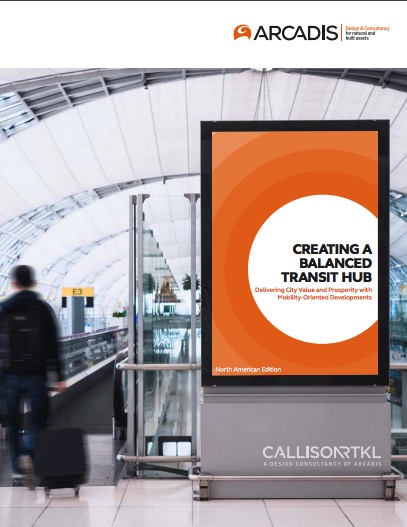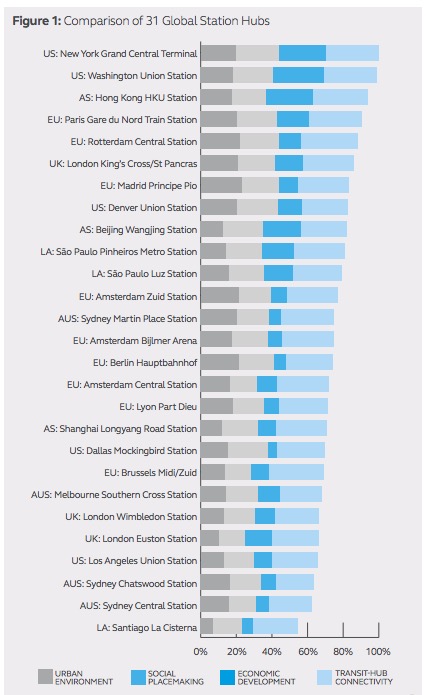ARCADIS
The Arcadis Mobility-Oriented Development Benchmark (MODe)
 Every city is dependent on mobility. Mobility enables people, goods and ideas to move in, out and within our cities, whether on its roads, on rail or in the air. And as urban centers continue to increase in size and density, mobility is becoming a more pressing issue for city leaders and residents. In today’s cities, journey times are increasing and transportation infrastructure is under greater pressure. There have been many discussions around alleviating stress on our roads through alternative modes of transportation such as rail, bus, bikes and more. These modes are and have been leading to transit-oriented developments, essentially transit hubs that are integrated into the area, being walkable, safe and vibrant.
Every city is dependent on mobility. Mobility enables people, goods and ideas to move in, out and within our cities, whether on its roads, on rail or in the air. And as urban centers continue to increase in size and density, mobility is becoming a more pressing issue for city leaders and residents. In today’s cities, journey times are increasing and transportation infrastructure is under greater pressure. There have been many discussions around alleviating stress on our roads through alternative modes of transportation such as rail, bus, bikes and more. These modes are and have been leading to transit-oriented developments, essentially transit hubs that are integrated into the area, being walkable, safe and vibrant.
With many cities and developers integrating restaurants, leisure activities and communal workplaces into or near airports and train stations, transit hubs are becoming a travel destination in and of themselves. Cities are seeing how these hubs can generate a ripple effect that encourages investment, provide new revenue streams and improve the overall quality of life in the surrounding neighborhood.
Finding the Right Balance for Transit-Oriented Developments
Typically, during development of a transit hub, each party is most concerned about the part of the development they have direct influence over or receive direct benefit from. Yet this approach limits the overall impact of a hub development and makes it more difficult to fully integrate the hub into the surrounding area.
There are several common practices which compromise on design potential. For example, to attract investment and generate an early return, many transit-oriented masterplans focus on high-end residential elements while neglecting other components that add broader social, economic and environmental value to the development. Equally, by focusing solely on road and rail connection plans, opportunities are missed to encourage the use of more sustainable transit options like shared vehicles, bicycles or trams. In these cases, development of the area around the hub is conducted piecemeal, rather than in tandem with its development.
The result is a transit-served development, rather than a transit-oriented development. Train stations, bus stations or airports often do not realize their full design potential; the various parts do not come together to form a cohesive whole and developments can fail to maximize their potential. Transit-oriented developments must be undertaken with a care for the area in which they are built, ensuring they are developed through a balanced approach to achieve greater longevity and economic vitality for the city.
MODe: Evolving Transit-Oriented Development
Arcadis’ integrated approach to such transit developments is called Mobility-Oriented Development, or MODe. With the MODe approach, we focus on how a station hub balances and integrates four key elements that bring the greatest value to transit-hubs: connectivity, urban environment, social placemaking and economic development. By quantifying these elements we created a rigorous framework for comparing transit hubs and measuring the balance among the four key elements. This allows us to see their untapped potential.
MODe is an evolution of transit-related planning and execution, ensuring transit hubs are balanced. It helps make them maximally efficient in their main task – transporting people and goods – while generating greater prosperity for both citizens and investors through multi-use residential and commercial services at the station hub. MODe serves both public and private stakeholders. By attracting additional private investments, MODe can maximize the return on investment in both the transit hub and the surrounding areas. This in turn helps to accelerate social and economic development in the area.
Transit-related developments are traditionally designed to do the following:
- Induce ridership
- Reduce driving
- Increase walking and biking
- Add convenience
- Increase density
- Encourage overall transit use
However, Mobility-Oriented Developments look at the bigger picture:
- Sustains ridership
- Discourages driving
- Anticipates new forms of mobility
- Makes walking and biking safer
- Offers wide range of mixed-use facilities
- Offers diverse placemaking that promotes enjoyment of the area
- Supports transit usage
The Arcadis Mode Benchmark: Realizing the Value of Mobility-oriented Development
 The purpose of the Arcadis MODe Benchmark is not to create a hierarchy of transit hubs but instead to indicate areas of opportunity to create a more balanced hub based on a sampling of transit stations. As the world continues to become more reliant on its urban centers, we hope that city leaders, economic developers and transit agencies see this as a valuable tool to assess their progress and align priorities for an improved quality of life.
The purpose of the Arcadis MODe Benchmark is not to create a hierarchy of transit hubs but instead to indicate areas of opportunity to create a more balanced hub based on a sampling of transit stations. As the world continues to become more reliant on its urban centers, we hope that city leaders, economic developers and transit agencies see this as a valuable tool to assess their progress and align priorities for an improved quality of life.
The benchmark has been constructed using indicators that measure the quality of the key elements that bring value to a development. In this way, a transit hub can be compared before and after its redevelopment, increases understanding of how sustainable multi-modal urban environments can be created and measures the main factors that optimize them for broader social benefit.
These considerations are important factors for creating a balanced transit hub. By looking at the leading practices among transportation professionals and city planners as well as missed opportunities observed at 31 transit hubs around the world, we can gain valuable insights into approaches that will allow us to optimize multi-mode transit hub designs.
Here are some ways in which the MODe Benchmark reveals the potential of existing or future developments:
- Showcases the ability to investigate how far investment in a transit hub contributes to the success and added value of the multi-modal urban environment, including higher property values, public spaces and increased revenue for local businesses,
- Helps discover where there is room for improvement,
- Quantifies qualitative measures,
- Compares the global performance of multimodal urban environments according to a range of key values for transit hubs.
The MODe Benchmark measures four key indicators, each built from several specific variables. Each variable has its own set of values to measure the score of the development and compare it to others. The MODe Benchmark reveals that station hubs are most attractive for working, living and investing when they are most balanced among the following key indicators:
1 Transit-hub Connectivity
Describes the quality of the transit hub in relation to the variety and quantity of transit modalities, its proximity to other important locations and facilities, and its provision of comfort to the traveler.
2 Urban Environment Assesses
the urban form of the environment and how sustainable it is. Urban form is determined by variables such as an area’s density and whether a development is mixed-use.
3 Social Placemaking
Weighs variables that contribute to a vibrant and multimodal urban environment. These include the quality of the public space and the variety of public facilities within the transit zone. It also looks at the resilience of a transit hub to climate change impacts, security vulnerabilities as well as traffic and passenger safety and security.
4 Economic Development
Evaluates the prosperity, economic activity and property value of the urban environment within Liverpool Street Station the transit zone, relative to national averages.
Download full version (PDF): Creating a Balanced Transit Hub
About Arcadis
www.arcadis.com
Arcadis is the leading global Design & Consultancy firm for natural and built assets. Applying our deep market sector insights and collective design, consultancy, engineering, project and management services we work in partnership with our clients to deliver exceptional and sustainable outcomes throughout the lifecycle of their natural and built assets. We are 27,000 people, active in over 70 countries that generate €3.2 billion in revenues. We support UN-Habitat with knowledge and expertise to improve the quality of life in rapidly growing cities around the world.
Tags: Arcadis, CallisonRTKL, Mobility-Oriented Development, Transit-Oriented Development






 RSS Feed
RSS Feed